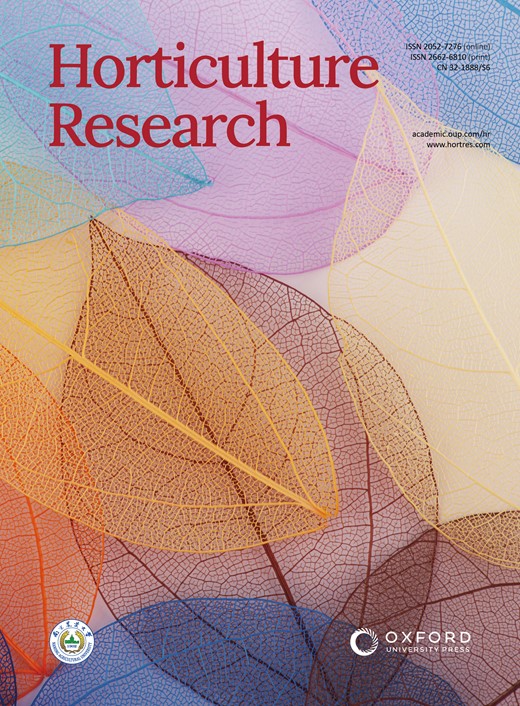两种富亮氨酸重复受体样激酶启动茶树的草食性防御反应
IF 8.7
1区 农林科学
Q1 Agricultural and Biological Sciences
引用次数: 0
摘要
富亮氨酸重复受体样激酶(LRR-RLKs)已成为草食性感知和随后防御启动的关键调控因子。虽然它们在禾本科植物中的功能已被逐渐阐明,但与草食性相关的 LRR-RLKs 在木本植物中的作用在很大程度上仍然未知。在这项研究中,我们挖掘了茶树(Camellia sinensis)的基因组和转录组数据,共鉴定出 307 个 CsLRR-RLK 成员。系统发育分析将这些 CsLRR-RLK 及其拟南芥同源物分为 14 个亚群。基因结构和保守结构域分析揭示了亚组成员之间的显著相似性。在已鉴定的 CsLRR-RLKs 中,我们重点研究了两种质膜定位的 LRR-RLKs,即 CsLRR-RLK44 和 CsLRR-RLK239,它们之间不形成同源二聚体或异源二聚体。它们都对食草动物有强烈反应,其表达模式与不同茶叶品种的抗食草动物表型有显著相关性。CsLRR-RLK44 和 CsLRR-RLK239 作用于丝裂原活化蛋白激酶(MPK)级联的上游,并调节防御相关 MPK 和 WRKY 转录因子的表达。此外,沉默 CsLRR-RLK44 或 CsLRR-RLK239 会降低草食性诱导的茉莉酮水平,从而削弱植物对茶尺蠖幼虫(Ectropis obliqua)的抗性。我们的研究首次证明,在木本植物中,LRR-RLKs 是通过激活包括 MPKs、WRKYs 和茉莉酸盐在内的典型信号转导来增强对食草动物抗性的关键。此外,我们的研究将 LRR-RLK 如何启动植物防御的机理研究从禾本科植物扩展到了具有重要经济价值的树种。本文章由计算机程序翻译,如有差异,请以英文原文为准。
Two leucine-rich repeat receptor-like kinases initiate herbivory defense responses in tea plants
Leucine-rich repeat receptor-like kinases (LRR-RLKs) have emerged as key regulators of herbivory perception and subsequent defense initiation. While their functions in grass plants have been gradually elucidated, the roles of herbivory-related LRR-RLKs in woody plants remain largely unknown. In this study, we mined the genomic and transcriptomic data of tea plants (Camellia sinensis) and identified a total of 307 CsLRR-RLK members. Phylogenetic analysis grouped these CsLRR-RLKs into 14 subgroups along with their Arabidopsis homologs. Gene structure and conserved domain analyses revealed notable similarities among subgroup members. Among the identified CsLRR-RLKs, we focused on two plasma membrane-localized LRR-RLKs, CsLRR-RLK44 and CsLRR-RLK239, which do not form homodimers or heterodimers with each other. Both respond strongly to herbivory, and their expression patterns significantly correlate with herbivore resistance phenotypes across different tea accessions. CsLRR-RLK44 and CsLRR-RLK239 act upstream of mitogen-activated protein kinase (MPK) cascades and modulate the expression of defense-related MPKs and WRKY transcription factors. Additionally, silencing CsLRR-RLK44 or CsLRR-RLK239 reduced the levels of herbivory-induced jasmonates, thereby weakening the plant resistance to tea geometrid larvae (Ectropis obliqua). Our work is the first to demonstrate that in woody plants, LRR-RLKs are essential for enhancing herbivore resistance through the activation of the canonical signaling, including MPKs, WRKYs and jasmonates. Furthermore, our study extends mechanistic insights into how LRR-RLKs initiate plant defenses from grasses to economically important tree species.
求助全文
通过发布文献求助,成功后即可免费获取论文全文。
去求助
来源期刊

Horticulture Research
Biochemistry, Genetics and Molecular Biology-Biochemistry
CiteScore
11.20
自引率
6.90%
发文量
367
审稿时长
20 weeks
期刊介绍:
Horticulture Research, an open access journal affiliated with Nanjing Agricultural University, has achieved the prestigious ranking of number one in the Horticulture category of the Journal Citation Reports ™ from Clarivate, 2022. As a leading publication in the field, the journal is dedicated to disseminating original research articles, comprehensive reviews, insightful perspectives, thought-provoking comments, and valuable correspondence articles and letters to the editor. Its scope encompasses all vital aspects of horticultural plants and disciplines, such as biotechnology, breeding, cellular and molecular biology, evolution, genetics, inter-species interactions, physiology, and the origination and domestication of crops.
 求助内容:
求助内容: 应助结果提醒方式:
应助结果提醒方式:


